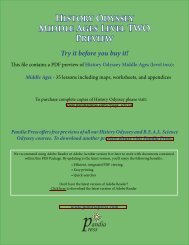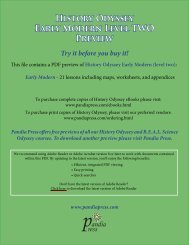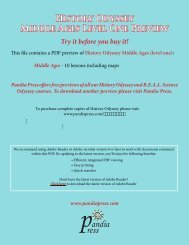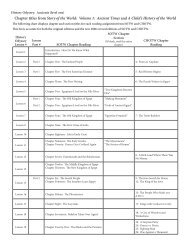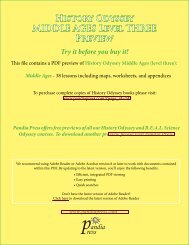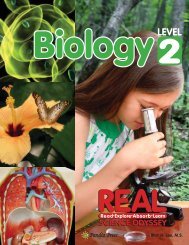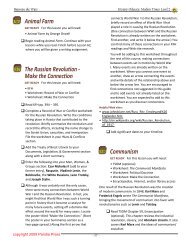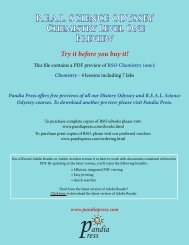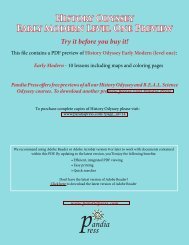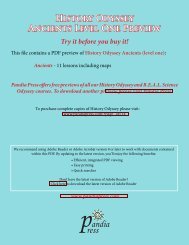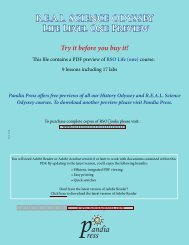REAL Science Odyssey Biology 2 Teacher Guide ... - Pandia Press
REAL Science Odyssey Biology 2 Teacher Guide ... - Pandia Press
REAL Science Odyssey Biology 2 Teacher Guide ... - Pandia Press
Create successful ePaper yourself
Turn your PDF publications into a flip-book with our unique Google optimized e-Paper software.
<strong>REAL</strong> <strong>Science</strong> <strong>Odyssey</strong> Chapter 1<br />
Explore<br />
Microscope<br />
Lab<br />
Your Microscope: Parts and Focus<br />
This lab is a beginner microscope lab. Students will learn the names for the<br />
parts of the microscope as well as how to focus the microscope. If your students<br />
are experienced microscope users, you might find they do not need to do this<br />
lab. Through the remainder of this course, it will be assumed your student has<br />
performed this lab, and knows the terminology and how to use a microscope.<br />
The instrucons for the first few microscope labs are very long. They are wrien<br />
for those students who have never used a microscope and want to know it all. They<br />
are instrucon manuals detailing proper technique, procedure, and terminology.<br />
Later in the text, the instrucons for the microscope labs shorten considerably.<br />
Through connued use, students will become very good at using a microscope.<br />
Part 1: Parts of the Microscope<br />
The purpose of the first part of this lab is to teach students the names of all the<br />
relevant parts of the microscope. See the next page for correct labeling.<br />
Students are not expected to memorize microscope terms. I expect they will<br />
learn the names of the parts of the microscope through connued use.<br />
Part 2: How to Focus Your Microscope<br />
This secon instructs students on the correct procedure for<br />
focusing a microscope. Students are expected to draw three<br />
pictures, each is a microscopic view of the paper and ink at one<br />
of the three magnificaons. The oil immersion lens will NOT be<br />
used with this lab. Next, students will look at a color picture from<br />
a catalogue. It is really interesng to see how all the colors in a<br />
catalogue are made by combining the same four colors of dots in<br />
different proporons.<br />
When viewed without<br />
MS letters look solid.<br />
Under MS there are<br />
parts of letters that<br />
look sprayed.<br />
This is an example of a completed<br />
microscope view sheet. Throughout this<br />
guide you will fi nd several such examples.<br />
These are for reference only. What your<br />
student views through the microscope could<br />
be vastly different than what is pictured in<br />
these examples.<br />
Lab sheet suggested answers:<br />
Bonus queson: Do you know the name of the molecule that<br />
makes up the fibers you are seeing at 400x magnificaon?<br />
cellulose<br />
“K” indicates black in the four-color print processing used for<br />
your catalogue picture (CMYK). But it doesn’t stand for the word<br />
“black.” Research what it does stand for and why. K stands for<br />
the word “key.” Way back when color prinng started, the black<br />
plate was called the key plate because it contained the arsc<br />
detail or “key” informaon. Today we say that K means “black,”<br />
so as not to confuse it with B (blue) in the RGB color model.<br />
16 <strong>Pandia</strong> <strong>Press</strong>



